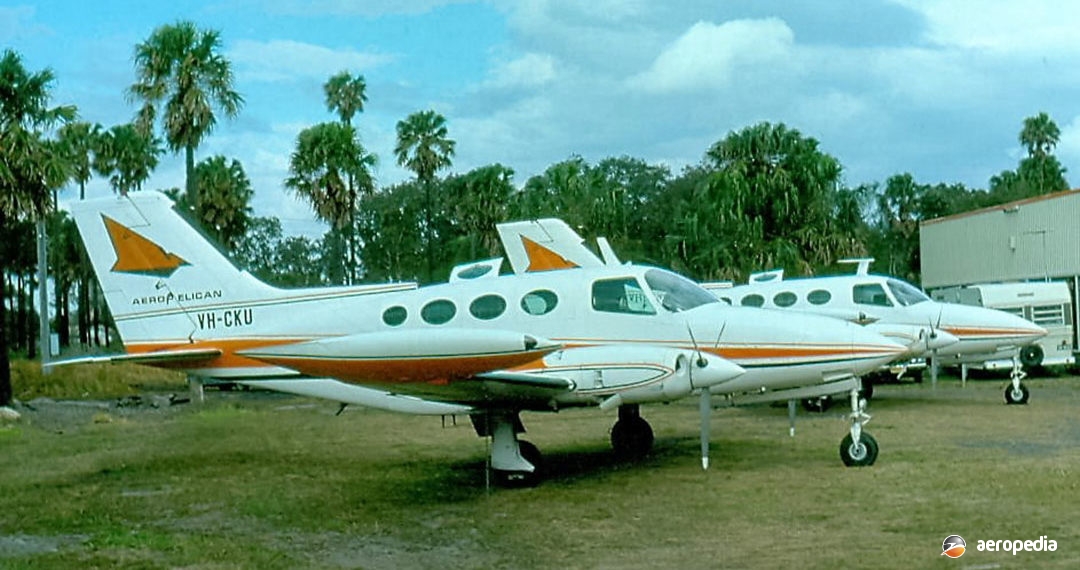Photograph:
Cessna 402C VH-CKU (c/n 402-0128) at Belmont, NSW (David C Eyre)
Country of origin:
United States of America
Description:
Business and executive aircraft
Power Plant:
Two 224 kw (300 hp) Continental TSIO-520-E six-cylinder horizontally-opposed air-cooled engines
Specifications:
- Wingspan: 12.15 m (39 ft 11 in)
- Length: 11 m (36 ft 1 in)
- Height: 3.56 m (11 ft 8 in)
- Wing area: 18.18 m² (195.7 sq ft)
- Max speed at 4,877 m (16,000 ft): 424 km/h (263 mph)
- Max cruising speed at 75% power at 3,048 m (10,000 ft): 356 km/h (221 mph)
- Rate of climb at sea level: 491 m/min (1,610 ft/min)
- Service ceiling: 7,980 m (26,180 ft)
- Stalling speed flaps down: 130 km/h (81 mph)
- Range at 276 km/h (171 mph) at 3,048 m (10,000 ft): 903 km (561 miles)
- Range at 387 km/h (140 mph) at 6,096 m (20,000 ft) with 552 kg (1,218 lb) and max fuel: 2,001 km (1,243 miles)
- Empty weight: 1,758 kg (3,875 lb)
- Loaded weight: 2,858 kg (6,300 lb)
History:
The prototype Cessna 401 was flown for the first time on 26 August 1965. Designed as a lighter and cheaper version of the Cessna 411, the Model 401 was aimed at the business and executive market but, in its developed form, the type was used in the commuter airliner role. The series was first offered in two models, the 401 and the 402. The former was intended for executive use with seating for up to eight, including the pilot. The Model 402, which was released for the third-level/commuter airline market, had a strengthened floor for carrying light cargo, and could accommodate up to ten in a commuter layout.
In 1971 the Model 402B appeared with a lengthened nose and was offered in two versions, the Utiliner and the Businessliner. At this time the Model 401 was dropped from the range. An optional feature of the Models 401 and 402 was a large cargo door which gave an opening of 114.3 cm by 101.6 cm (45 in x 40 in) to facilitate freight loading. A two-piece airstair door with steps, which extended or retracted automatically when the door closed or opened, was also fitted, with the top half opening upwards.
In 1979 the Model 402C appeared with an increased useful load of 158 kg (349 lb) and accommodation for two extra passengers. Better performance was achieved by the installation of up-rated 242 kw (325 hp) turbocharged Continental engines. This model had a lengthened bonded ‘wet wing’, rivet elimination, increased aspect ratio, and the elimination of the wingtip fuel tanks. The engines were also moved by a further 12.7 cm (5 in) towards the wingtips to give a greater propeller-to-fuselage clearance. This model also had a new undercarriage with a faster retraction time, a feature borrowed from the Cessna 414 Chancellor.
The first Model 402 seen in Australia VH-BKL² (c/n 0004) was the first aircraft off the production line for the Australian distributors, Rex Aviation. In its standard form the Model 402 in its initial production model carried its fuel in 189 litre (41.6 Imp gal) wingtip tanks but auxiliary 76 litre (16.7 Imp gal) tanks could be installed in each wing outboard of the engines. This model had 224 kw (300 hp) Continental TSIO-520-E engines, giving a useful load of 1,207 kg (2,661 lb) in the 6.06 m³ (222.4 cub ft) cabin, or 812 kg (1,790 lb) of cargo, or a pilot and eight passengers with luggage on short-haul operations. As a passenger aircraft the Model 402 had three luggage compartments; the nose held up to 159 kg (350 lb), and each of the wing lockers held 54 kg (120 lb), giving a total of 277 kg (590 lb).
When production ceased in 1985 some 1,535 examples of the 402 series had been built. More than 70 examples have appeared on the Australian register, and operators over the years have included Murray Valley Airlines in Victoria and Aero Pelican based at Belmont, NSW. At least six have appeared on the New Zealand register.

